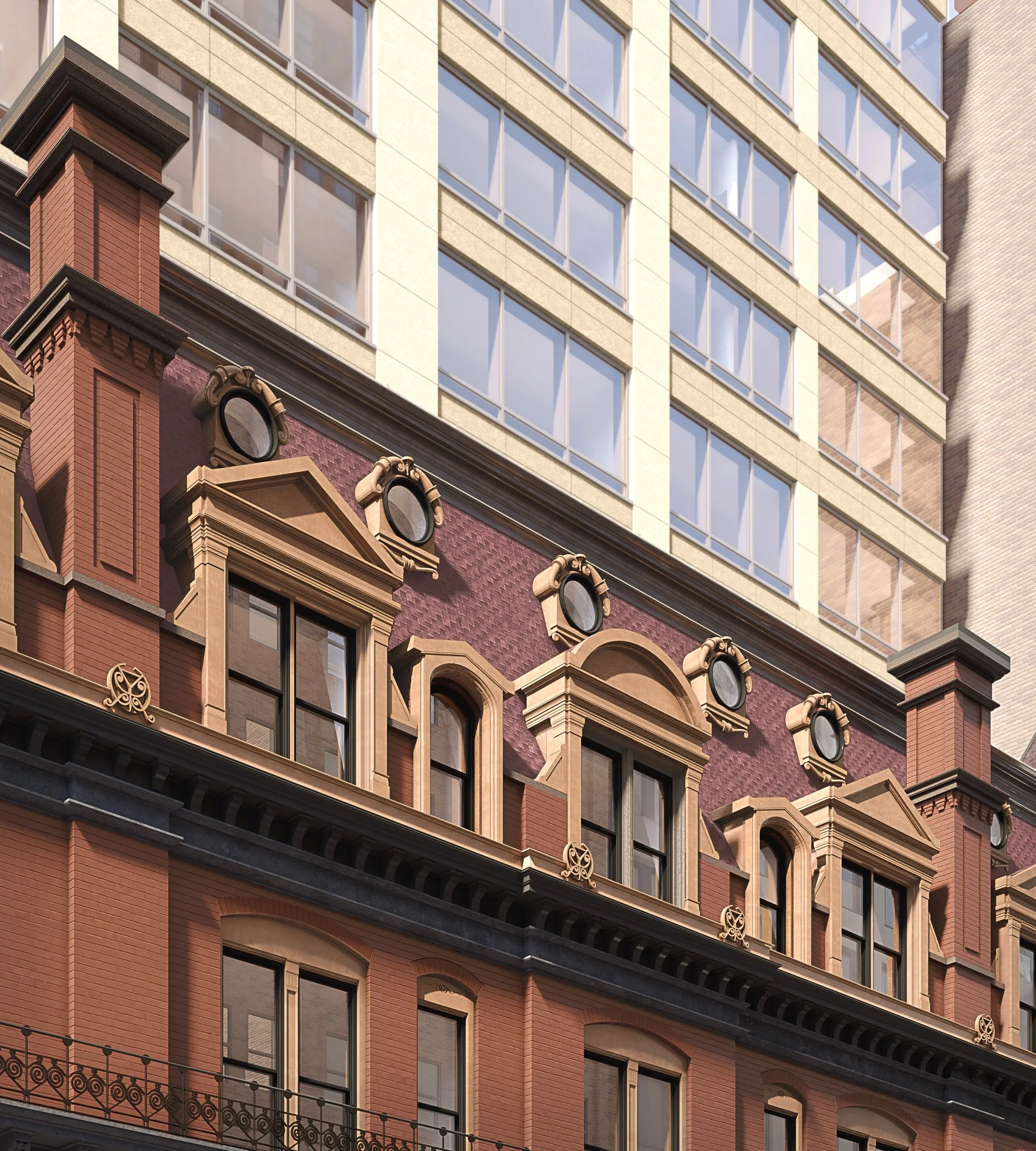251-253 Fifth Avenue: the Turret and the Tower
“LPC Approves 20-Story Redevelopment At 251-253 Fifth Avenue In NoMad, Manhattan”
YIMBY
The restoration of 251 and the design of the new 20 stories tower have been approved by the Landmarks Preservation Commission during the course of two meetings
Historical Research, Preservation, Architectural Design, Visualization, Agencies’ Filing (DCP and LPC)
251-253 Fifth avenue
the regeneration of a landmark as a statement of urban regeneration
251-253 Fifth Avenue: the Turret and the Tower
Architect: TRA Studio
Preservation Architect: TRA studio
19 stories mixed-use tower, 94,000 square feet
Design Team: Caterina Roiatti, Robert Traboscia, Winston Wolf , Gabriel Ovelar, Ashley Mandat
The restoration of 251 Fifth Avenue, built in 1872, 251 Fifth Avenue, designed in Queen Anne style by George B. Post, the demolition of 253 Fifth Avenue and the proposal for a new tower to rise along and partially above the historic structure, have been approved by the Landmarks Preservation Commission during the course of two meetings.
The site is located in the Madison Square North Historic District at the Intersection of the Flatiron and the Madison Square districts, at the center of the quadrants between north and south, downtown and midtown, the east side and the west side.
The Madison Square Park North District is a neighborhood of exceptions, marked by deviations to the grid as well as by architectural exceptions, diversified typologies and a vast collection of styles, materials and scales, the diversified character of the context is most visible in the areas surrounding the site, where the exception is the rule.
The development is poised to become a landmark along Fifth Avenue and the turret of 251 Fifth Avenue will become once again visible from the park, as originally intended. The restoration will bring back the historical significance of 251 Fifth Avenue by completely restoring it and replicating the elements that have been removed by recreating, as closely as possible, the conditions of a 1905 well-known photograph.
The massing strategy of 253 Fifth Avenue is informed by the idea that the air parcel above the historic building contains DNA that shapes the design of the new building, this approach unifies the massing into an integrated whole. The new tower sculpts itself, nodding at the primacy of the historic building, into a form that is at once innovative and reminiscent of the mansard roofs and stepped setbacks found in the area.
The gesture is a simple one: rather than proposing a cantilever above the historic building, the proposal builds with the existing, by mean of a small encroachment. The plane of the 251 Fifth Avenue mansard roof is extended to move the bulk away from the front façade and turret. The mansard roof on the left side of the 251 Fifth Avenue turret is, at once, the separation and the connection, between and with the abutting building. This intentional action is highlighted in the proposal, shifting the weight of the volume towards the back, freeing the turret. The 28th Street wall rises above the Fifth Avenue side creating a large dormer, similar to the dormers that top the two muscular buildings on this stretch of Fifth Avenue, 261 and 249 Fifth Avenue. The design bridges the temporal divide in a way that skillfully and elegantly stitches the new tower to the Landmark.
TRA was so successful in making the case for a tall building on the block that one of the LPC Commissioners stated that “the building could even be taller”.
The Fifth Avenue and 28th Street façades, share the same materials and similar language, while responding to their unique conditions. A clear hierarchy is established between the 5th Avenue and 28th Street façades, despite the apparent simplicity, the treatment of both facades, is at once, repetitive and varied, to produce a façade evocative of the historic detailing while maintaining a contemporary and timeless expression.
The Fifth Avenue facade is in alignment with the street wall of the adjacent buildings, characterized at the lower floors by large commercial windows, placed within mortar-set terracotta tiles.
The North secondary façade turns the corner to capture the Empire State Building views. The vertical line of windows recalls the light wells seen on the side walls of buildings in the district.
The muted palette of the new building, colors and textures, harmonizes with the surrounding buildings and provides a backdrop to the varied materials and vibrant colors of the historic building.
The new tower is not designed as a stand-alone isolationist object, it is simultaneously distinct and part of a whole. The new building is, at once, a suitable backdrop to the historic building and a proud contributor to the vertical density of the street wall, it embraces the districts eclectic characteristics. while supporting the significance of the historic landmark.
Heritage conservation, creative reuse and new construction in historic districts overlap and inform each other: the conversion, (or retro-version), to residential and regeneration of the historic building is also a statement of urban regeneration, its restoration will bring back the original vision, renewing the significance to the site, the block and the district and make the Madison Square North area once again memorable. The Turret and the Tower are clearly distinct but one can never be seen without the other, the combination of the two can only augment the significance of each, they work as partners, respectively representing the old and the new, each enhancing the other.
As it often happened before, one successful project generated more work along the street .251-253 Fifth Avenue/aka 1 East 28th follows the recent completion of 128 East 28th Street, a new mid-rise condominium located on a small lot in the busy area of Kips Bay.
#251 Fifth Avenue, #Turretand Tower, #Madison Square North Historic District, #Mixed Use Development NYC, #Landmark Preservation, #Urban Regeneration, #NoMad, #Queen Anne Style Architecture, #Skyscapers, #TallBuildings
Links:
“The recent influx of residential conversions and new developments has, and continues to bring, a new vibrancy to the district. The proposed restoration and new building will greatly contribute to this transformation”
City Realty
LPC Approves 20-Story Redevelopment At 251-253 Fifth Avenue In NoMad, Manhattan
YIMBY
Tall Buildings in Historic Districts: Caterina presents 251-253 5th Avenue at the Center for architecture (click here for video)
CFA
Tall buildings in historic districts: panel at the center for architecture
Tall Buildings in Historic Districts, video
Local Today
https://youtu.be/W6vco4Io9Rg?t=10419
Landmark Presentation Commission presentation
































